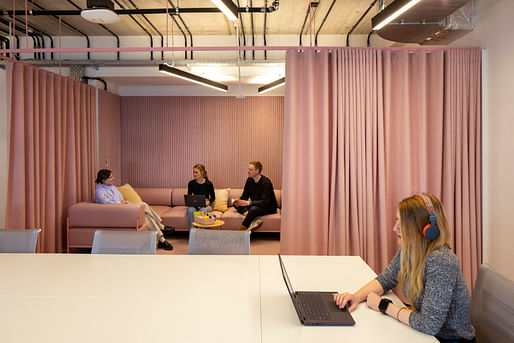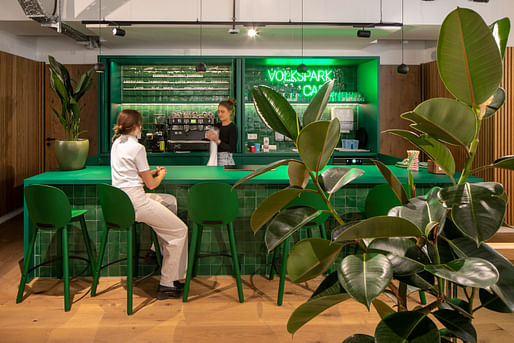
MVRDV has offered an insight into their recently-completed interior redesign for Shopify in Berlin. The 1,000-square-meter (10,700-square-foot) renovation began before the COVID-19 pandemic but was heavily altered mid-construction to respond to post-pandemic work trends.
Adopting the view that individual tasks would continue to be fulfilled remotely, the pivot in Shopify’s renovation sought to maximize the building’s potential as a “base for working collaboratively with others, brainstorming new ideas, and engaging in the company’s vibrant culture.”
“This project gave us an exciting opportunity to think critically about how workspaces can be reimagined after 2020,” said MVRDV partner Fokke Moerel about the scheme. “Now people can work from home — and for a company like Shopify, whose work is primarily remote-first, that’s even easier. In turn, what was once an office becomes a space for employees to collaborate with intention, brought to life by design touches that reinforce the unique spirit of the city they’re in.”
The resulting renovation, which primarily covers the ground, basement, and sixth floor of the building, is described by MVRDV as a “re-think of the purpose of [Shopify’s] physical workspaces.” The renovation comprises three “on-site” rooms, which serve as primary meeting rooms as well as several “experience rooms” designed for company gatherings and casual work environments.
Each “on-site” room is equipped with a typical conference table and a so-called “color lounge” — an adjacent space separated by a curtain to create a more comfortable environment for free-flowing discussions. The colors themselves were chosen to reflect Shopify’s visual identity.

The “experience rooms” include two areas used for lunches and gatherings, adorned with plants supplied by a local company. Below, the “club” experience space references Berlin’s famous nightlife with space for events and casual socializing, surrounded by a wall-mounted continuous screen. On the same level, a “secret room” provides a private meeting space with what the team describes as a “clandestine atmosphere, perfect for breaking out of the day-to-day mindset in more high-stakes work projects.”
Elsewhere, the project sought to offer visual clues to its location in the city’s Berlin-Mitte district. The reception desk, for example, contains blue-green “metro tiles” in reference to the city’s public transit stations, while the opposite wall features an art piece by Carolyna Amaya titled Intersections, which celebrates the city’s vibrant street art.
Despite the post-pandemic adaption occurring while the renovation was already underway, the team sought to re-use elements from the half-built project, including wall and floor finishes, lighting fixtures, and furniture.

News of the scheme’s completion comes one month after MVRDV unveiled their intention to convert a structuralist icon in the Netherlands into a new residential district. In May, the firm’s vibrant Rotterdam Rooftop Walk officially opened, as did their NEXT500 Pavilion exploring the future of social housing.
No Comments
Block this user
Are you sure you want to block this user and hide all related comments throughout the site?
Archinect
This is your first comment on Archinect. Your comment will be visible once approved.